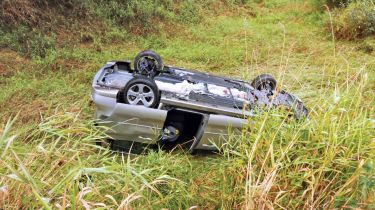New Cat S and Cat N insurance write-off classifications have replaced the old Cat C and Cat D groups; we explain all.
The UK’s latest car insurance write-off categories were first introduced in October 2017, with the new Cat N and Cat S classifications replacing the former Cat C and Cat D. But what else has changed with the new classifications, and do the same caveats about buying a written-off car, such as conducting a history check, still apply?
These categories were updated to better reflect the increasing complexity involved in repairing modern cars. If you are searching for a used car, it is important to note that cars that were originally assessed as being Cat C or Cat D won’t be reassessed.
Old Cat C and Cat D insurance write-off categories explained
When a car is involved in an insurance claim following an accident, or is damaged as a result of fire, flood or theft, the insurance company will assess it to judge if it’s worth repairing, and the extent of the cosmetic and structural damage. Their findings will then result in them assigning the car a category. This determines the resulting repairs that will need to be carried out, and gives future buyers an extra indication as to what to look out for.
What is Cat S and Cat N damage?
A Cat S car is one which has sustained structural damage during a crash – think items such as the chassis and suspension. While Cat S cars can safely be repaired and put back on the road, they must be re-registered with the DVLA.
Cat N classification encompasses all non-structural damage, such as body panels, lights, and the infotainment system. As with Cat S cars, Cat N vehicles can be put back on the road but they do not need to be re-registered with the DVLA – though you will still need to inform them your car has been written-off in the first place.
In effect, Cat N and Cat S replace the old Cat D and Cat C categories respectively, albeit with modifications to their remits.
What does Cat S and Cat N damage mean?
Updating the write-off categories means that buyers looking at vehicles which have been in a major accident will get a better idea of the type of damage sustained. What’s more, the registration certificate – the V5C – will now be marked with an ‘S’ to signify that the car has been salvaged, so buyers will be better alerted to cars with a write-off history.
High-mileage cars: should you buy one?
The changes have not affected the Cat A and B classifications. Cat A cars have to be crushed, and none of their parts can ever legally be reused. Cat B (the ‘B’ stands for ‘break’) cars also have to have their body shells crushed, but can be broken up for parts before that happens, with salvageable components being resold.
Insurance write-off categories at a glance
- A. Scrap
- B. Break
- S. Structurally damaged repairable
- N. Non-structurally damaged repairable
Should I buy a Cat S or Cat N car?
The same caveats apply to Cat S or Cat N cars as apply to Cat C and Cat D vehicles: buyer beware.
Firstly, conducting a background check on a car should show whether a car has ever been declared as a write-off. A seller is legally required to inform a potential buyer of this fact, so if they fail to do so, walk away as they could be trying to hide a hidden past.
Once you have determined a car’s history, it’s important to be sure of the standard of all repairs carried out when the car was returned to the road. If you are viewing a potential write-off purchase, it is a very good idea to get a professional inspection before signing any paperwork – this is particularly important with structurally-damaged Cat S cars.
Cheapest cars to insure in the UK 2021
Another thing to be aware of is that insurance can be harder to come by for written-off cars, with some providers not covering them at all. While this can be overcome by hunting around, insurance for Cat S and N cars (likewise C and D) tends to be more expensive than it is for non-written-off cars.
Written-off cars are also worth less than their undamaged counterparts. While this should be reflected in their purchase price, you may find it hard to sell a Cat S or Cat N car, as some buyers will simply not consider them.
Looking for a used bargain? Take a look at our Best cars for £5,000 or less…
Source: Read Full Article


 Old Cat C and Cat D insurance write-off categories explained
Old Cat C and Cat D insurance write-off categories explained High-mileage cars: should you buy one?
High-mileage cars: should you buy one? Cheapest cars to insure in the UK 2021
Cheapest cars to insure in the UK 2021